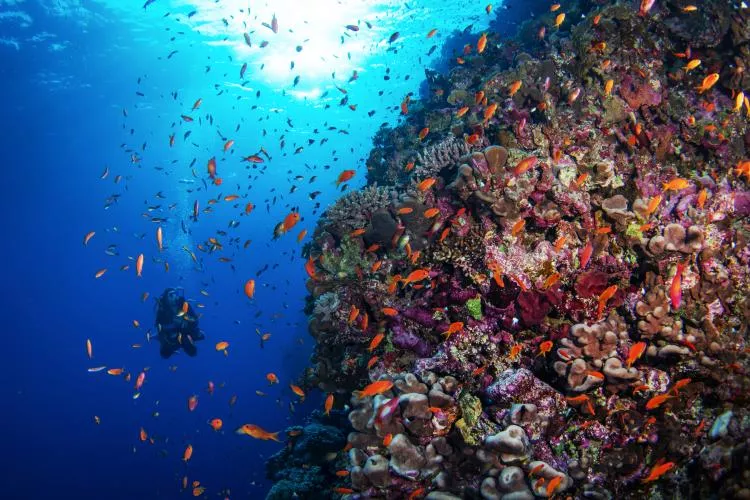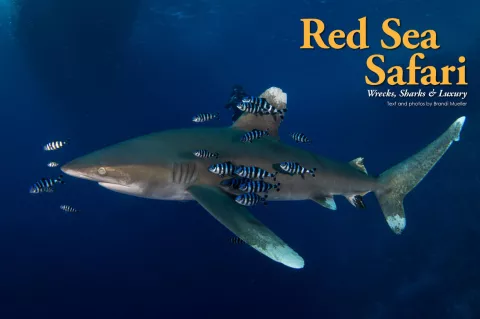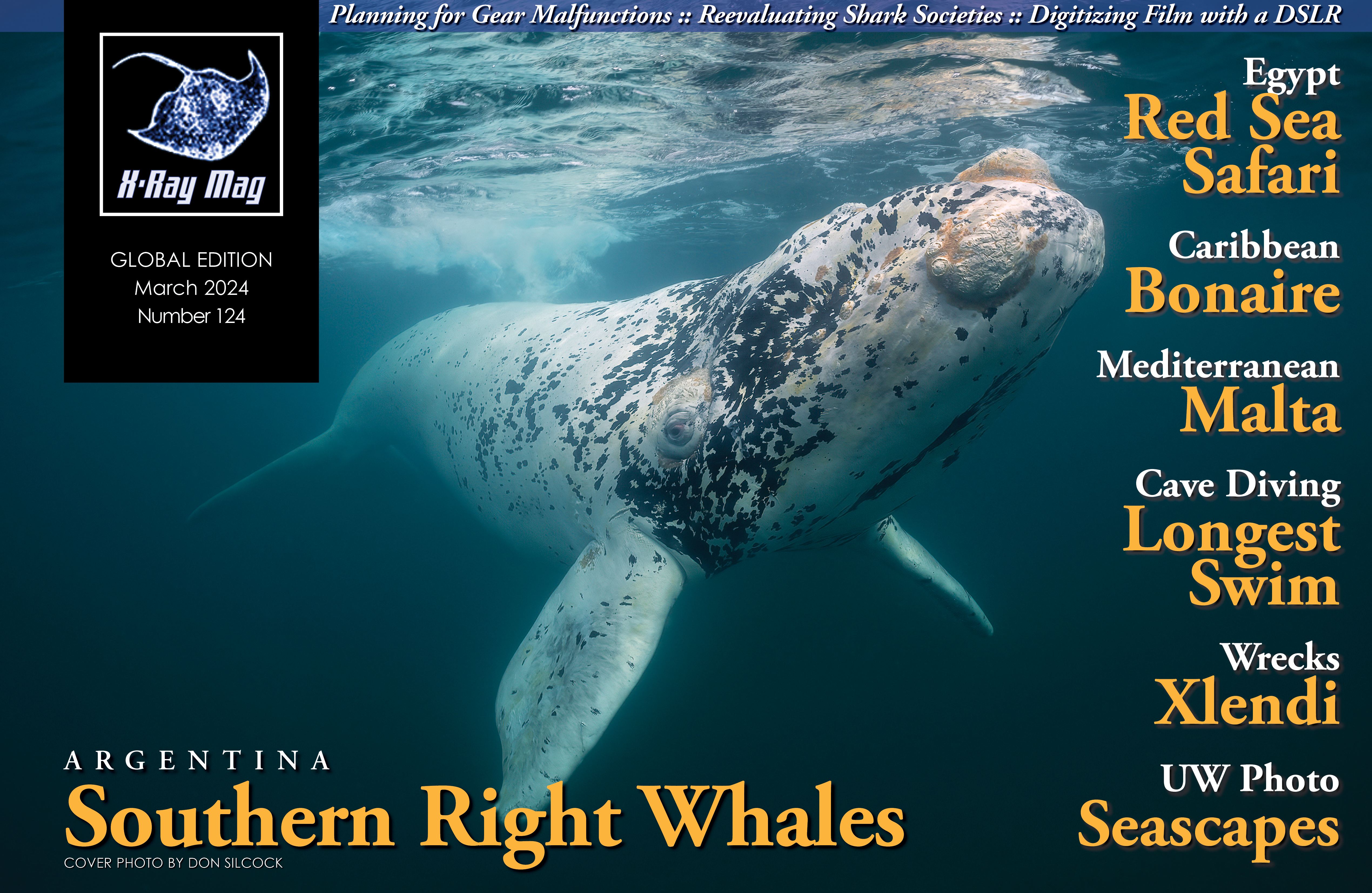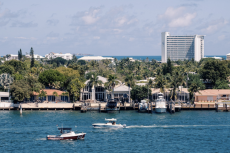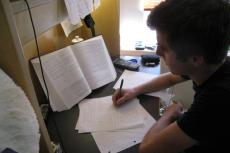The Egyptian Red Sea offers divers beautiful reefs with plentiful marine life as well as wrecks to explore and photograph. Brandi Mueller takes us on a liveaboard safari that starts in Hurghada.
Contributed by
Like on most liveaboards, my tank had been refilled and was standing at my designated spot on the dive deck. I retrieved my mask and fins from my bin below my spot on the bench and had them ready for the dive. My wetsuit had been hung above my station during the surface interval, but now that it was dive-time, the hard-working crew had removed it from the hanger, reversed it back so it was no longer inside-out and laid it over my gear. After climbing into the wetsuit, I un-bungeed my tank and put my arms through my BCD straps, with the assistance of a crew member (who had been standing by, waiting to help). I buckled it and started my pre-dive mental checklist.
Dive computer was on my wrist, mask, fins, weights… weights! I felt for my weight pockets, and they were empty. Thoughts ran through my mind about where I had them last. After our previous dive on the fast boat, I had passed up my weights before the tank, and I was supposed to get them from the back deck when we got back. I had forgotten. My eyes had gone to my waist as I felt the empty spaces and when I moved my head back and looked up, Mohammed was standing in front of me, weight pockets in hand, as if he were presenting me a gift.
After a dive trip, it is often the case that I find myself reporting that the attentive crew seemed to anticipate divers’ needs, even before the divers knew what they needed. But the crew of the All Star Scuba Scene take this to a new level. Never before have I realized I forgot something, only to look up at that moment and have a crew member appear with it before me. Plus, weight pouches are usually not very unique and hard to tell from others (mine included)—how did he know they were mine? Even if I had been the only one who had forgotten to pick them up, how could he tell I did not have them in my BCD already? The fantastic crew of the Scuba Scene work in mysterious ways.
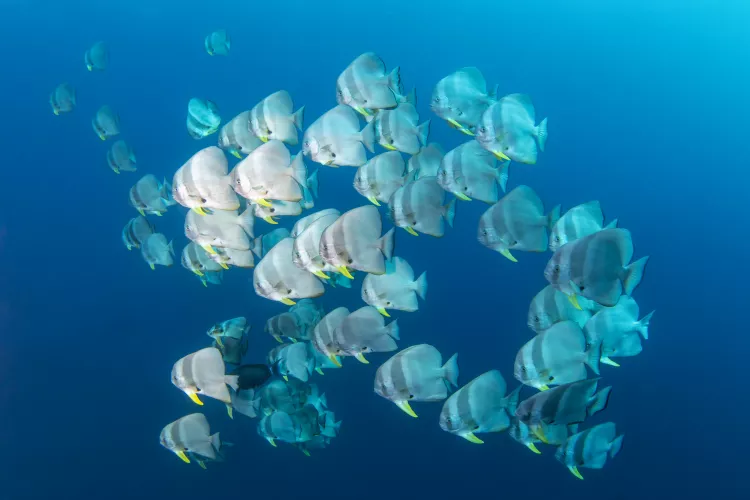
Oceanic whitetip sharks
Weight pockets in place, I finished my pre-dive check and jumped off the back of the stylish teak deck of the 157ft (48m) liveaboard. It was December, and the clear waters of the Red Sea were starting to cool off, but I was cozy in my 5mm wetsuit and hood.
The dive plan was to swim along the wall at Big Brother Island and descend down, near a plateau before the deep drop-off, to look for sharks. Hammerheads, threshers and gray sharks were all a possibility, as was the focus of my attention, the oceanic whitetip sharks. This species tends to be found closer to the surface, though.
Along the wall, thousands of bright orange anthias made the reef look as if it were moving, and there were more cornetfish than I had ever seen in one area before. Their long, silver, pipe-like bodies were like gleaming lines patrolling the reef in groups. I headed down to nearly 110ft and looked out into the blue, spending about ten minutes there before giving up on the deeper sharks and heading back to shallower depths in hopes of seeing oceanic whitetip sharks.
I was hoping to get a photo of an oceanic whitetip shark worthy of Dr Elke Bojanowski, our onboard shark expert and the founder of the Red Sea Sharks trust; she was also our cruise director for the week. She had been studying sharks for over 20 years, and one of her projects was using photos (collected over many years) to identify individual sharks. In an onboard presentation, she told us how oceanic whitetip sharks can be identified by unique markings on their fins. The goal was to get photos of both sides of the shark’s dorsal fins, pectoral fins and tail. With these, she could match them with where the shark had been seen before.
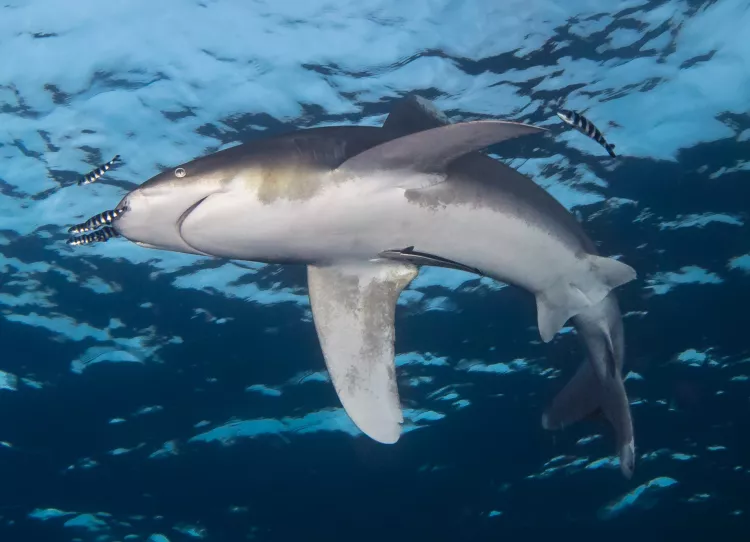
At the end of my dive, when I was almost back to the boat, I looked up, and there was an oceanic whitetip shark. Dr Bojanowski had also told us to remain calm, keep eye contact and change our position in the water to a standing position instead of the usual horizonal trim. Oceanic whitetip sharks were “confident and curious,” according to her presentation, and it was important to not appear to be prey, or they might get a little too curious.
I did as instructed and watched the shark from afar, hoping it would come closer. It seemed to approach by circling in, close to the divers, and then circling back out. It would then return, a bit closer, for another circle around us divers.
Then, I noticed it was coming straight for me. With camera ready and a quick check to make sure I was in the right position, the shark approached within a few feet of me. Shots were snapped, and I hoped I got something good.
Back on board, I was excited to share my images with Dr Bojanowski and maybe add one more photo to her collection for science. This is one of the many ways that we, as divers, can be citizen scientists and help researchers around the world. It may be a small thing, but lots of small things add up to big things.
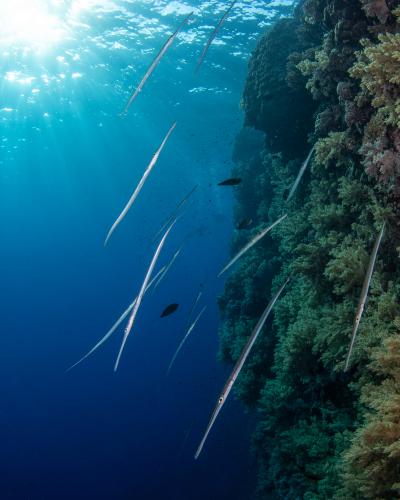
During shark season in the Red Sea, Dr Bojanowski hosts Shark Week trips where divers have a normal week on the liveaboard but also have nightly shark presentations, and the boat visits the dive sites getting the most shark action. Divers are encouraged to share their photos of sharks from the Red Sea with the Red Sea Shark trust, no matter which boat they dive from, what time of year, or which dive site.
The liveaboard
Our week started out in Hurghada, which I had reached relatively easily with a flight from Brussels in Belgium, and a flight from Chicago before that. The boat, which can hold up to 26 divers, had quite a few cancellations due to situations happening in nearby countries. But in Egypt, things did not seem to be any different, albeit with the same impact one may have experienced at home. We visiting divers had all watched the news to get updates and learn about the conflicts but did not see them directly affecting us. The cancellations meant that the already massive boat had even more space for each of us.
The Scuba Scene is one of the largest liveaboards in operation and also one of the newest. It started trips in the spring of 2023. It is so big that in my jet-lag haze on the first night, I could not remember how to get to the dining room, after our initial tour. There are five deck levels starting with a massive, partly shaded sundeck at the top, with a hot tub and tons of seating space. The next level down has more sun and shaded lounge space, a drink and snack bar, a huge salon where we did our briefings and even a TV room (which I never even got around to visiting). Below that level is a pool, yes, a pool. Sun lounge chairs surround it, and there is a nook where we sometimes had breakfast and snacks. Outward-facing cabins were also on that level. Next was the level where the majority of the cabins were located, as well as the dive deck. Below that was the dining room.
Usually, cabins end up in that lowest “below-deck” level. I really appreciated the change in the normal layout on this vessel. With recent tragic liveaboard events, it makes so much more sense that the sleeping quarters are above the water line. If something were to happen, it would most likely take place at night, and the higher up that sleeping people are, the better. If something were to happen at mealtime, people are more alert, and it would be easier for them to find their way through escape routes.
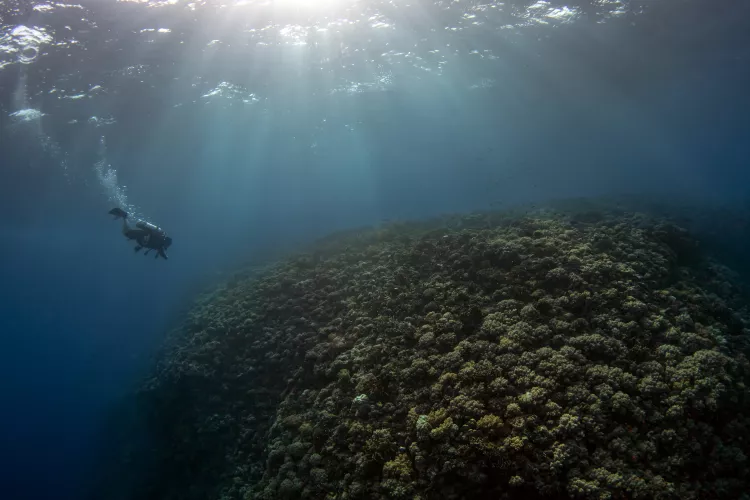
Safety
Which brings me to safety on the Scuba Scene. The safety briefings on arrival and the first morning were some of the best and most thorough that I have seen in all my years of diving on liveaboards. I respected how applicable they were to the specific boat. Instead of just stating that there were emergency hatches in certain places, they used photos and videos to show the exact escape routes and encouraged us to check them out. We also found life jacket locations and had to demonstrate that we knew how to use them.
One thing that really stood out was that the night watch (which is obviously mandatory) were held accountable in doing their duties with the use of QR code stickers throughout the vessel. When the night watch did their rounds, they had to take a photo, which would have a time stamp, of each sticker to prove that they actually went everywhere. One would never expect crew members to not be doing what they are supposed to, but this sort of verification makes it tough to cut corners, and there is documentable proof of safety. I thought this was a great idea and a high standard that other companies should implement as well.
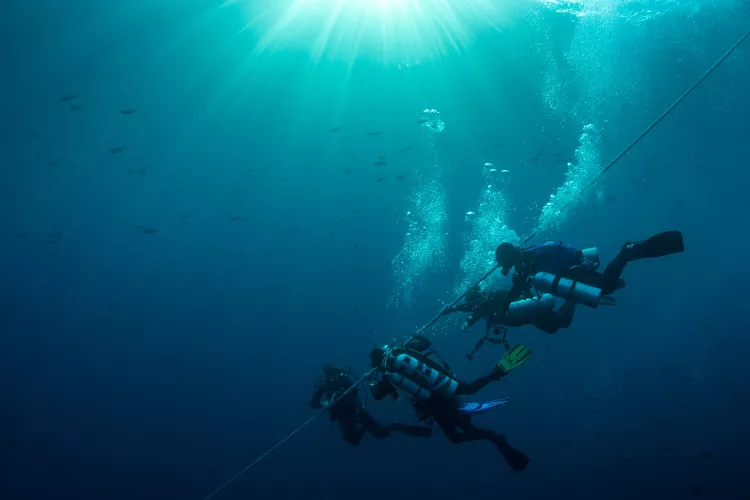
Diving safely
I also noticed how our first day of diving was set up to train us on how to dive on this specific boat and to be safe while diving. As we would be doing dives from the main ship as well as from the two fast boats, our first dive was off the back of the liveaboard. The crew requested that we do weight checks upon entry, and at the end of the dive, deploy our SMBs to make sure we were comfortable doing so.
One thing people do not always talk about is how an empty scuba cylinder can change one’s neutral buoyancy. Here, the crew brought this to our attention and said we should finish our dive with our tanks low (750psi/50bar) and check our weights to make sure we could stay down for a safety stop, comfortably.
Our second dive was from the fast boats. Again, it was a great way to practice and learn the liveaboard’s method of diving from the skiffs in easy conditions, so that on future days, when there might be choppy or strong currents, we would be comfortable doing so.
With lots of help from the crew (I swear they would carry us to the skiffs, if we asked), we got into the fast boats, and the crew helped us put our fins on. Arriving at the drop location, we put on our masks (I tried to dunk my mask over the side of the boat, but a crew member stopped me and did it for me), then on the count of three, we back-rolled into the water.
When the dive was over, we passed up our weights first, then our gear. With assistance, we climbed up an easy ladder and sat back in the fast boat. Then, we were offered water and dates during the short ride back to the liveaboard where we were met with juice and warm towels. I kept thinking that I had better not get too used to all this service!
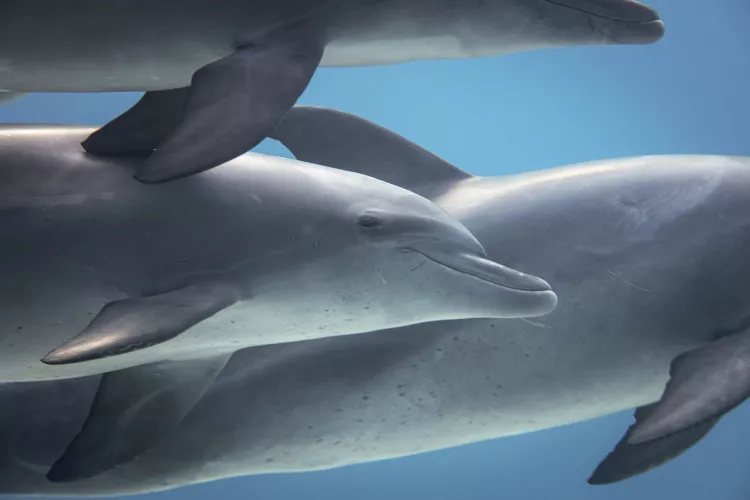
On some dive boats, “checkout dives” can end up being at dive sites that may not be so great. Assuming this, I put on my macro lens (there is always something macro to shoot), and our first dive was a lovely reef near Hurghada.
I was right below the boat, checking for critters in small reef clusters in the sand, when I looked up to see a bottlenose dolphin almost staring me in the face. It was one of those typical photographer-moments, where I thought, “It figures, I’ve got the macro lens on!” But I took a few shots with my 105mm lens anyway.
About six dolphins encircled us and stayed almost five minutes, giving everyone a great look at them. So much for the checkout dive being mediocre!
Heading north
Our itinerary on this trip included wrecks and reefs. After our day of diving the Brothers Islands, the liveaboard headed north overnight, to add a few wrecks to our dive list. The WWII British SS Thistlegorm was one of the wrecks we visited, and I had been lucky to dive this amazing wreck before.
The devastating loss of the ship occurred in October 1941, after making its way here from Britain, the long way around; the ship had traveled all the way south, past the horn of Africa and back up the coast into the Red Sea. When approaching the Suez Canal, the entrance had been blocked by a collision, and the ship anchored until it was possible to enter the canal. Unfortunately, German aircraft found it first and dropped two bombs on the stern of the ship, sinking it.
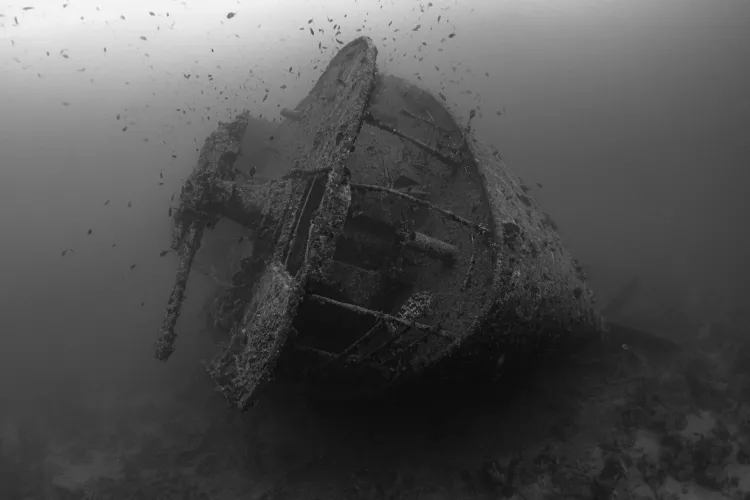
This ship is now an underwater museum of artifacts of the time, my favorite being the dozens of BSA motorcycles sitting in the beds of Bedford trucks. Since my last trip, I had been envisioning a photo shoot in one of the cargo holds with these trucks and motorcycles, so I convinced a few of my new dive friends to join me.
My plan was to set up off-camera lights, at least three 15,000 lumen Kraken Sports video lights, as well as having my divers “butt light” each other. This is where you swim right behind a diver, and with a very bright light, try to illuminate the diver from behind.
With my dive models, we discussed this whole plan. It started with me entering the cargo hold to set up the off-camera lighting and the models waiting until I was done, to try and reduce sediment falling from the ceiling from bubble disruption. Once I was ready, I would signal them in, and they would go to the opposite corner and swim towards me, one lighting the other. Once they reached me, they would pass the light and switch places and do it again. If it worked the first time, we would be finished, and I would collect the lights. We also had a signal if we needed to do it again and what to do if the models needed to end the dive.
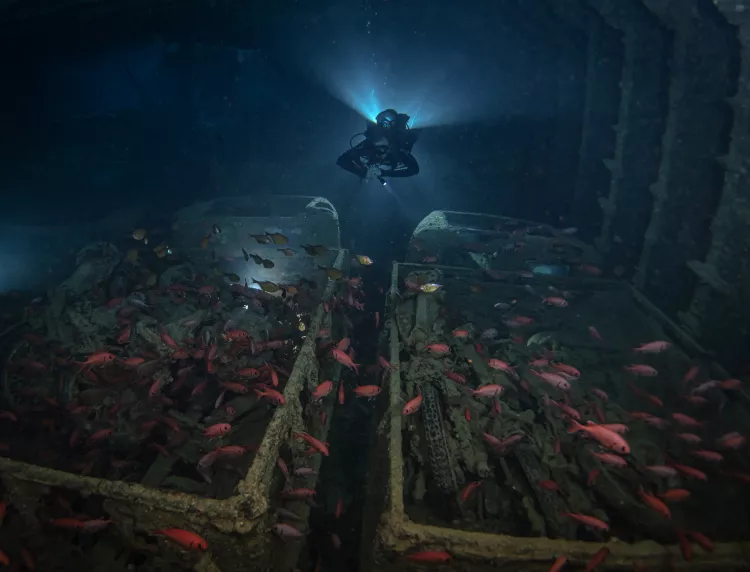
Underwater, our plan worked almost like clockwork. We only had a few hiccups with other divers swimming through our scene. But overall, it went great. Once we were finished, I grabbed the lights and still had some time to explore a few other cargo holds and photograph more motorcycles. It is always really nice to have divers willing to help out with images like these, and hopefully they find their time worth it for the results.
As I made my way back to the line connected to the stern of the Scuba Scene, I looked up to confirm that I was on the right ascent line by looking for the Scuba Scene flag, which hung below the boat. Often, popular sites like the Thistlegormreceive many boats at one time, and they end up tying off together in a mess of lines. It would be easy to go up to the wrong boat, and trust me, I wanted to return to our boat for hot towels!
I saw our boat’s flag and also noticed a massive school of batfish above me. During my entire safety stop, they hung out in a school right next to me.
Service and beyond
I never like coming back to the surface after a dive (it is better underwater, right?), but coming back aboard the Scuba Scene was delightful. At the ladder, the crew would take my camera and fins, help me to my seat, unzip my wetsuit and wrap a warm towel around my shoulders. Before I could even get my first stage off, there was juice, and as soon as I was finished playing with my gear, it seemed like it was always time for a meal—be it breakfast, lunch, snack time or dinner.
The food was not to be missed, especially the sweets. I have a bit of a sweet tooth, and the liveaboard had its own pastry chef aboard all trips! I just wanted to eat dessert first, most of the time, and the afternoon snacks of donuts and pastries were my favorite. The main meals were incredible too, including steak and salmon, and on our last night at sea, there was a huge rack of lamb, which our chef carved and served in front of us.
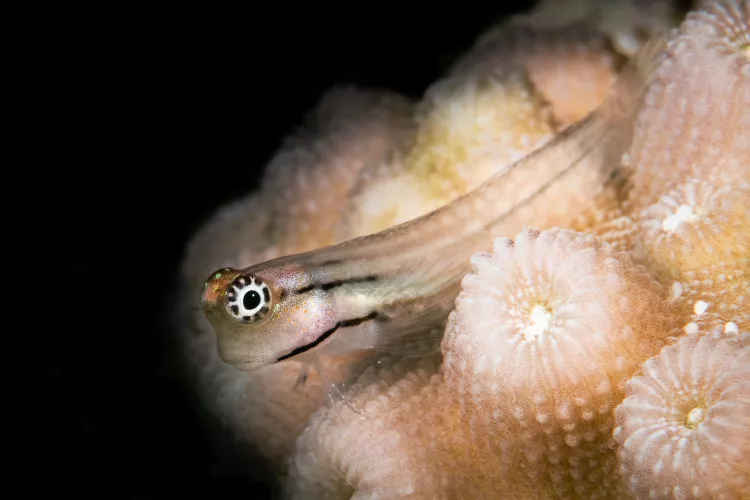
Wreck diving macro
After three amazing dives on the Thistlegorm, we moved to another wreck site called The Barge. There was not much left of the barge, just the remains of the bottom and outside hull, which rose only a few feet from the seafloor. However, it created a nearly bowl-like structure, which now harbored an immense amount of marine life.
I remembered from a previous trip that I had found cardinalfish brooding eggs in their mouths, hiding on what would have been the outside of the ship. I went searching where I thought I had seen them before. Sure enough, I found several cardinalfish, hardly moving. Looking closer, I spotted one that looked like it had a golf ball in its mouth, the sides of the lower jaw stretched out and almost transparent. These were the signs that the cardinalfish had a brood of eggs.
Every few minutes, cardinalfish need to run water over their eggs to keep them clean and free of algae. If you wait long enough, you may be rewarded with a millisecond in which they spit the eggs out of their mouths to rotate them, and then suck them back into their mouths.
I waited and waited for this to happen, and this fish just would not cooperate with my photographic demands. But it did keep opening its mouth wide (probably with the same effect of having the water run past the eggs and aerating them). I was able to get some shots of the eggs in the mouth of the fish, with its teeth like a prickly white fence protecting its babies. Later, back on the boat, I reviewed the images, and I could even see the eyeballs of the tiny babies inside the eggs, through that transparent, stretched part of their father’s jaw.
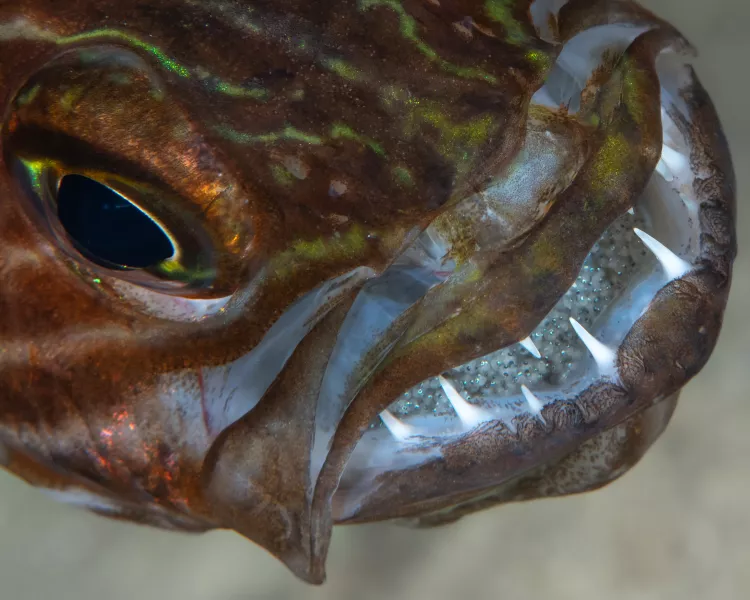
After spending far too much time with that one cardinalfish and its future offspring, I moved just slightly down the side of the barge and found another one with an extended jaw and took several photos. Luckily, the dive site was almost entirely around 30ft in depth, so I could spend plenty of time taking photos.
Swimming over to the other side of the barge, I saw something large moving in the sand. Getting closer, I saw that it was a stonefish, out and about, walking around. Usually, these fish are found buried in the sand, with only their stony-looking faces visible. Watching this one sort of hop-walk slowly along the sand, I looked in the direction it was sluggishly moving, and there was a second stone fish! That one was mostly buried in the sand.
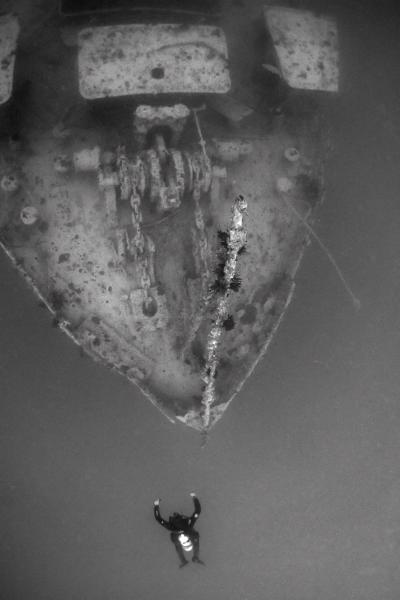
Again, the shallow depth allowed me to stay for a long time, waiting to see if something was going to happen. Were they going to fight? Were they going to mate? I waited and waited, but the slow-motion action was not going very fast. I checked my dive computer, which said I had been down 70 minutes. The crew had requested that we be back on board after 75 minutes, so I left the slow-moving love affair to go to my safety stop and back to the surface.
Rosalie Moller
On our final morning, we started off at the wreck of the Rosalie Moller, another British WWII wreck that was sunk two days after the Thistlegorm, also by German aircraft. The captain of the ship had seen the explosion of the Thistlegorm and asked permission to move his ship, so the same thing would not happen to it, but he was denied; and two days later, his vessel was struck by two aircraft bombs. This wreck now sits a bit deeper than the barge, with the top deck around 100ft (30m) and a maximum depth in the sand at 165ft (50m).
The wreck was remarkably different underwater though. With almost no growth, this ship still looked very much like a ship and was quite intact. The depth made it a bit darker, and it had an eerie feel to it. I swam with one of the dive guides, Ata, along the top of the wreck and could see a bathtub and toilet in one area, as well as the fallen smokestack and both fallen masts.
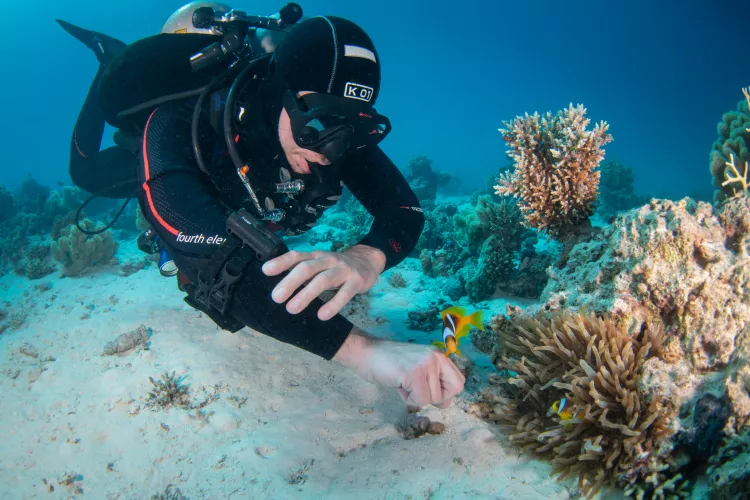
Nemo
Our final dive of the week was at Dolphin House. This dive site was known for dolphins; however, I had been here numerous times and never saw dolphins. This time we did see some playing off in the distance, but they did not come to visit on the dive. It was still a fantastic dive though.
The coral reef was magnificently covered in hard corals. It was a breath of hope to see the density and diversity of hard corals on the reef, and I could not help pausing for a moment to admire it. Not to mention, this was an incredibly popular site for divers and snorkelers. There were at least ten boats in the area when we arrived. However, it was great to see the healthy coral, even with lots of humans around.
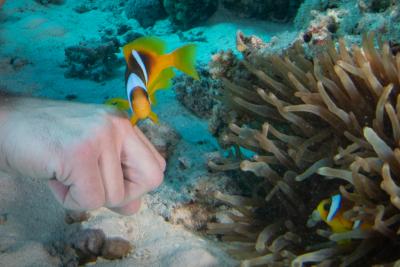
With my dive buddy, Nick, we were swimming along the point where the reef met a sand channel when an anemonefish swam right out of the reef and up into Nick’s face. Chances were, it had eggs and was defending its future offspring from predators. Nick turned around to face it and the bold, tiny fish charged at his face. I started laughing and snapping photos, as Nick put his arm out and the fish bit his hand. However, after the fish bit him, it turned to go back to its host anemone, and in one of the photos I took, it looks almost as if the fish fist-bumped (fin-bumped?) him. It was pretty adorable.
Heading back to the pier in Hurghada, the crew helped us wash and dry our equipment, and we spent our last afternoon and evening chatting with new friends about our trip and future dive plans.
All good things come to an end, and the next morning, after packing and saying goodbye to the crew, we disembarked from the boat. I had a moment then, as we all walked down the pier together to go our separate ways to airports or hotels. Someone made us stop to take a selfie, with a phone on the ground facing straight up into the sun, and then another person, with her own phone, took more selfies. We laughed as we walked, and my mind flashed back to arriving at the boat a week prior.
I had been a little confused about the pickup time and arrived after everyone else was already there. I walked into the salon to fill out paperwork and into a room of complete strangers. It is so amazing how, on some dive trips, you start out on a boat full of people that you have never met, and then part ways, with arms wrapped around each other, hugging and exchanging contact details.
I always say that diving brings together a special group of people, but I think it is also the atmosphere in which we meet that fosters this community. The All Star Scuba Scene sets the stage for bringing people together, making it all the more likely to turn strangers into friends. You can hardly help but have a good time, make new friends and lifelong memories. ■
Thanks go to All Star Scuba Scene liveaboard, staff and crewmembers.

